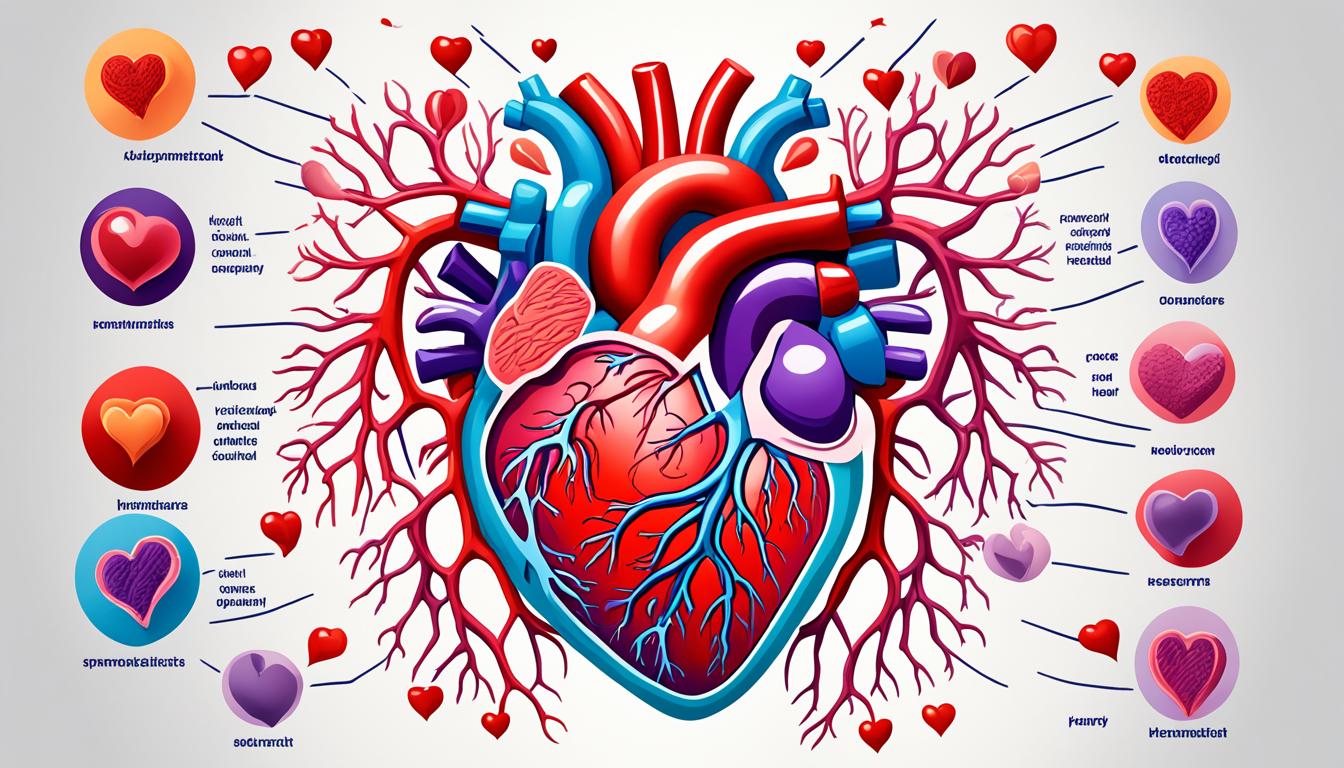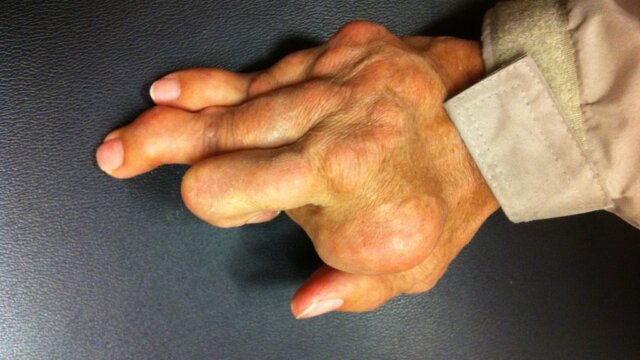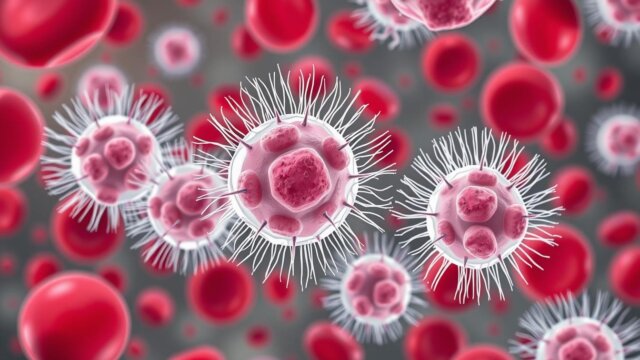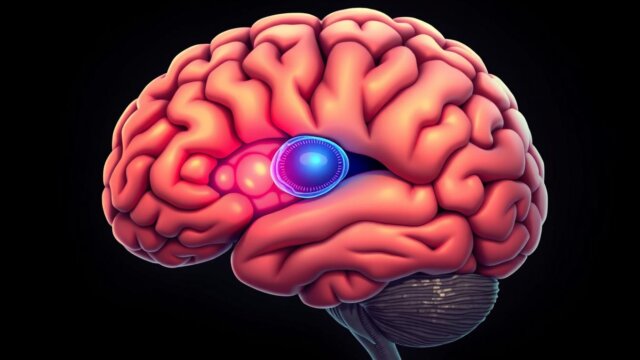FTC disclaimer: This post may contains affiliate links and we will be compensated if you click on a link and make a purchase.
Did you know that congenital heart defects affect 1 in 120 babies born in the United States? They are the most common type of birth defect. In the US, about 1 million adults and 1 million children live with these conditions. These heart issues can be simple or complex; special care is needed to keep blood flowing correctly.
These defects can affect the heart’s valves, walls, or blood vessels. They are either cyanotic or Acyanotic. Sometimes, we don’t know why they happen. But things like genes, mom’s health during pregnancy, and some substances can play a part. Luckily, thanks to better treatments, almost all kids with these heart issues can grow up.
Key Takeaways
- Congenital heart defects are the most common type of birth defect in the United States.
- These conditions can involve issues with the heart’s valves, walls, or blood vessels and can be classified as either cyanotic or Acyanotic.
- Causes of congenital heart defects may include genetic factors, maternal health during pregnancy, and exposure to certain substances.
- Treatment options include medication management and surgical interventions to ensure proper blood flow and oxygen circulation.
- Advancements in medical care have enabled nearly all children with congenital heart defects to survive into adulthood.
What Are Congenital Heart Defects?
Congenital heart defects mean the heart has problems that have existed since birth. These happen when the heart or blood vessels don’t form correctly during fetal growth. They can affect any part of the heart, like arteries, valves, or the walls between chambers. Some defects are mild, while others require quick medical help.
Definition and Overview
These defects are the most common birth issue, happening to about 1% of babies in the U.S. each year. They can be simple, like a “hole” in the heart, or very serious, like missing chambers or valves.
Types of Congenital Heart Defects
- Aortic Valve Stenosis (AVS)
- Atrial Septal Defect (ASD)
- Coarctation of the Aorta (CoA)
- Tetralogy of Fallot
These are some examples of congenital heart defects. The type affects how symptoms, treatment, and future health will be.
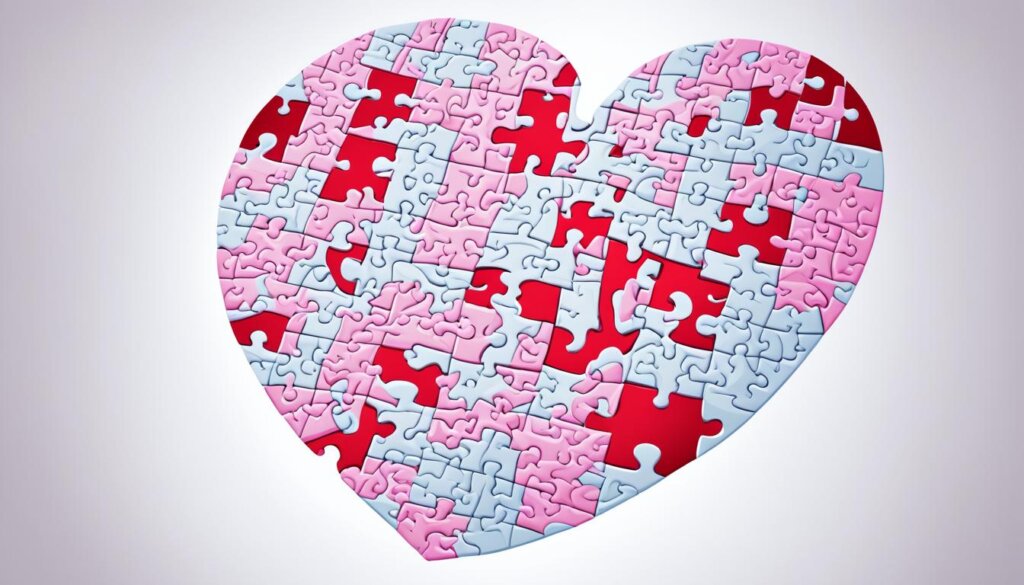
Some congenital heart defects may not appear until later, but serious ones can appear soon after birth. It’s key for kids and adults with these conditions to see a cardiologist regularly.
Causes of Congenital Heart Defects
Most congenital heart defects have no clear cause. They likely come from a mix of genes and environmental factors. Genetics are key, as the condition often runs in families and is passed down. Genes linked to heart issues at birth show how genetics affects congenital heart defects.
Environmental factors during pregnancy also play a part. Infections like rubella can affect the heart’s development. Diabetes in mothers, especially type 1 or type 2, can impact the heart’s growth in the womb. Some medicines, like lithium for bipolar disorder or isotretinoin for acne, are linked to congenital heart defects.
Lifestyle choices during pregnancy can increase the risk. Drinking alcohol and smoking during pregnancy are linked to heart issues in babies. This shows why a healthy lifestyle is crucial for pregnant women.
Risk Factor | Increased Risk of Congenital Heart Defects |
|---|---|
Down’s syndrome | About 50% of children with Down’s syndrome have congenital heart disease |
Maternal diabetes | Women with diabetes (type 1 or type 2) have a higher risk of giving birth to a baby with congenital heart disease. |
Fetal alcohol spectrum disorder | Children with foetal alcohol spectrum disorder can have congenital heart disease. |
Maternal rubella infection | Pregnant women who contract rubella during the first 8 to 10 weeks of pregnancy can put their unborn babies at risk of congenital heart disease. |
Maternal flu infection | Women who experience flu during the first trimester of pregnancy are at a higher risk of having a baby with congenital heart disease. |
Certain medications | Certain medications, like certain anti-seizure drugs, acne medicines, and ibuprofen, are linked to an increased risk of congenital heart disease in babies. |
Maternal phenylketonuria | Mothers with phenylketonuria who do not follow a low-protein diet and dietary supplements have a higher likelihood of giving birth to a baby with congenital heart disease. |
Organic solvent exposure | Exposure to organic solvents can increase the likelihood of having a baby with congenital heart disease. |
Understanding congenital heart defects involves both genes and the environment. Knowing the risks helps doctors and parents take steps to lower the chances, which can help ensure better outcomes for children with these heart issues.
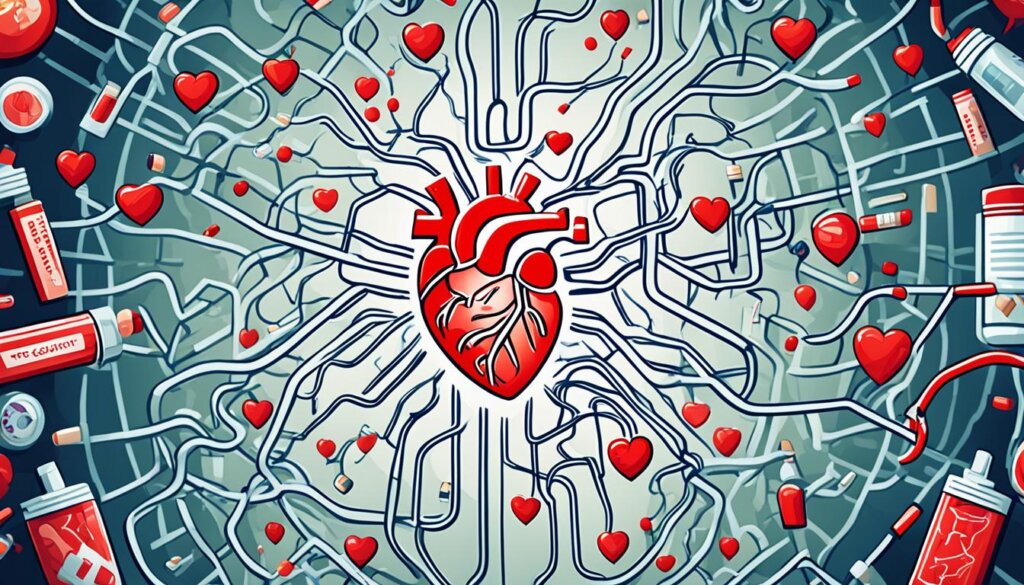
Symptoms of Congenital Heart Defects
Congenital heart defects can show different signs based on the child’s age. Babies often look pale or blue, breathe fast, have trouble eating, and don’t gain weight. These signs mean the heart can’t move blood and oxygen well around the body.
Signs in Infants
Newborns with congenital heart defects may look blue, breathe fast, eat poorly, and not grow well. These signs point to heart problems that make it hard for the baby to get enough oxygen.
Signs in Older Children
Older kids with these defects might feel short of breath, get tired easily, have swollen arms and legs, and hear strange heart sounds. These signs can get worse if the heart issue isn’t treated.
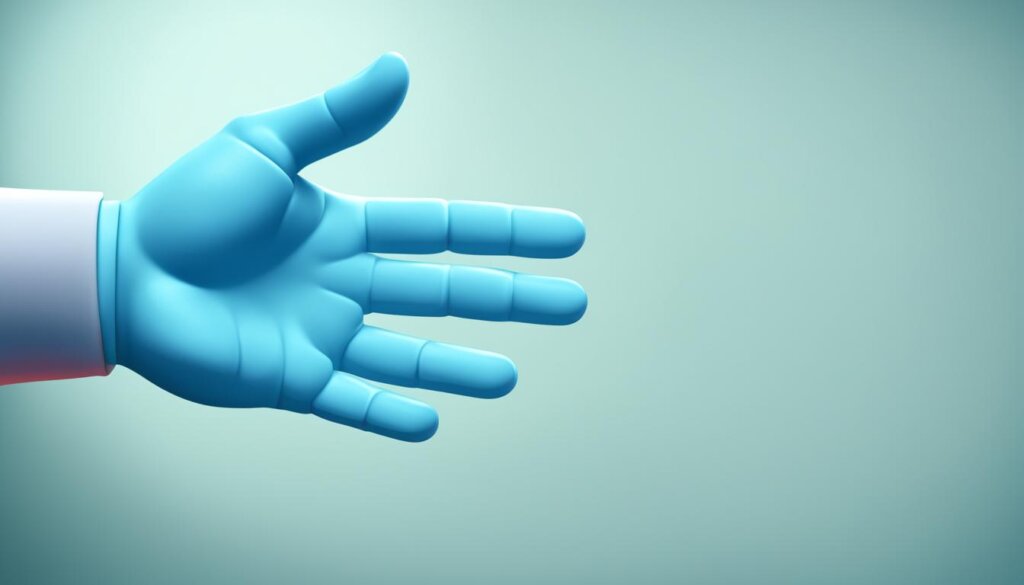
The severity and symptoms of congenital heart defects vary greatly based on the type and complexity of the defect. Finding and treating these issues early is key to helping children with them.
Symptoms of Congenital Heart Defects | Infants | Older Children |
|---|---|---|
Cyanosis (Bluish skin color) | ✓ | |
Rapid Breathing | ✓ | |
Difficulty Feeding | ✓ | |
Poor Weight Gain | ✓ | |
Shortness of Breath | ✓ | |
Fatigue with Exercise | ✓ | |
Swelling in Extremities | ✓ | |
Abnormal Heart Sounds (Murmurs) | ✓ |
Diagnosis of Congenital Heart Defects
Diagnosing congenital heart defects is a detailed process that includes a thorough physical check-up and various tests. Doctors are key in spotting these issues early, which helps in starting treatment quickly and improving results.
Physical Examination
The first step is a detailed physical check-up. Doctors listen to the heart with a stethoscope for unusual sounds or murmurs. They also ask about symptoms, medical history, and family heart issues.
Diagnostic Tests
Doctors use different tests to confirm the diagnosis and learn more about the heart. These tests include:
- Pulse oximetry: This test checks the oxygen in the blood, showing how well the heart works.
- Electrocardiogram (ECG): This test records the heart’s electrical activity to spot problems.
- Echocardiogram: This ultrasound makes detailed heart images, helping doctors see its structure and function.
- Cardiac catheterization involves inserting a thin tube into a blood vessel to measure blood flow and pressure directly.
- Chest X-ray: This test shows if the heart is too big or if there’s too much blood in the lungs, which could mean a heart defect.
Sometimes, tests like cardiac MRI or genetic testing are needed for a full picture. The type and timing of tests greatly affect the outcomes for those with congenital heart defects.
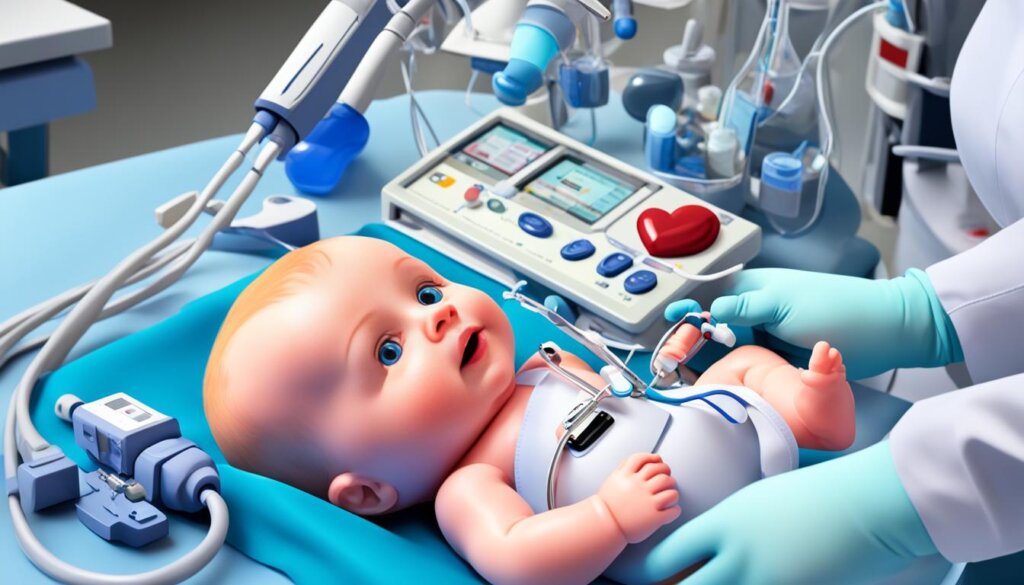
“Early and accurate diagnosis is crucial for developing an effective treatment plan and ensuring the best possible outcomes for individuals with congenital heart defects.”
Congenital Heart Defects During Pregnancy
Are you expecting a child and worried about congenital heart defects? The good news is that fetal echocardiography can often catch these during pregnancy. This special ultrasound checks the baby’s heart. It helps doctors watch the situation closely and plan for care.
These heart defects can be mild or serious. About 1 in 4 babies has a serious heart defect that needs treatment soon after birth. This means around 25% of babies with heart defects need surgery or treatment in the first year.
If a heart defect is found during pregnancy, your healthcare team might suggest more checks or special care. This can help make things easier for your baby as they grow. It also makes sure they get the best start in life.
Type of Congenital Heart Defect | Treatment |
|---|---|
Coarctation of the aorta (COA) | Surgery or balloon angioplasty |
Dextro-Transposition of the Great Arteries (d-TGA) | Heart surgery soon after birth |
Interrupted aortic arch (IAA) | Surgery soon after birth to repair the aorta |
Pulmonary atresia (PA) | Medication to improve blood flow until treated with cardiac catheterization or surgery |
Single ventricle defects | Surgery to repair or replace valves may need pacemakers |
Tricuspid atresia | Surgeries to increase blood flow to the lungs and bypass the part of the heart that’s not functioning properly |
Tetralogy of Fallot (TOF) | Heart surgery soon after birth to improve blood flow to the lungs and the rest of the body |
Total anomalous pulmonary venous return (TAPVR) | Surgery to improve blood flow through the heart |
Truncus arteriosus (common truncus) | Surgery to repair heart and blood vessels |
Finding a congenital heart defect during pregnancy can be scary, but with the right care, many babies do well. In fact, over 85% of babies with these defects live into adulthood.
If you’re worried about congenital heart defects during pregnancy, talk to your healthcare provider. They can offer guidance, support, and the care you and your baby need for the best outcome.
Treatment Options for Congenital Heart Defects
Treatment for congenital heart defects can be with medicine or surgery, based on how serious the condition is. Some heart defects get better on their own without treatment. But serious ones often need treatment.
Medication Management
Medicines can help control symptoms, keep heart rhythms steady, or reduce fluid buildup. For example, some heart defects are treated with indomethacin, ibuprofen, and acetaminophen. Diuretics and digoxin may also be used before or after surgery.
Surgical Interventions
Severe defects might need surgery, like open-heart surgery or catheter-based procedures, to fix the heart. Cardiac catheterization is used for simple defects like atrial septal defect and patent ductus arteriosus. But, this method has risks like bleeding, infection, pain, and blood vessel damage.
In some cases, a heart transplant is needed if the defect can’t be fixed. Sometimes, surgery is done on babies who are too small or weak for full surgery. This surgery helps with blood oxygenation. Ventricular assist devices and total artificial hearts help support heart function in people with these defects.
The goal of treating congenital heart defects is to fix the specific problems and improve the patient’s health and life quality. The success and risks of treatment depend on the defect’s type and severity. This shows why personalized care and ongoing checks by doctors are key.
“Proper treatment and management of congenital heart defects can significantly improve the long-term prognosis and quality of life for affected individuals.”
Living with Congenital Heart Defects
People born with congenital heart defects (CHDs) must manage their condition and live a healthy life. Many can’t be fully cured and may face new health issues over time. This depends on their heart defect type, number, and severity. Getting regular medical care is key to staying healthy.
Lifestyle Adjustments
Living with CHDs means making some lifestyle changes. Some babies grow and gain weight slowly, and some have trouble feeding because they get tired easily or burn more calories. After treatment, their growth and weight usually get better. Some kids with heart defects might have poor oral health, like bad teeth or cavities. Seeing a pediatric dentist often can help keep their teeth healthy.
Being active can make the heart stronger, so doctors should suggest safe exercises for people with heart defects. Adults and parents need advice on what activities are okay. People with heart defects might need special care for their reproductive and heart health. Seeing a cardiologist often is important to make good health choices. Some adults need doctors who specialize in adult congenital heart defects.
People with congenital heart defects can live full lives by adjusting their lifestyles and working closely with doctors. With the right care, they can overcome the challenges of their condition and do well.
“Proper ongoing medical care plays a crucial role in helping children and adults with heart defects live healthy lives.”
Lifestyle Adjustments | Importance |
|---|---|
Dietary changes | To accommodate slower growth and weight gain in some children with CHDs |
Activity modifications | To ensure safe physical activity that can benefit the heart’s strength |
Regular dental care | To maintain good oral health in children with CHDs |
Specialized medical care | For managing reproductive and heart health in individuals with CHDs |
Cardiologist visits | To make informed decisions about health for individuals living with CHDs |
By adjusting their lifestyle and getting the right medical care, people with congenital heart defects can overcome their challenges and live full lives. With help from their doctors and a focus on their health, they can achieve their goals.
Every year, nearly 40,000 infants in the U.S. are born with a congenital heart defect. Kids with complex CHDs are more likely to have anxiety, and adults with CHDs often have mood or anxiety disorders. The American Heart Association and the Children’s Heart Foundation have given almost $15 million for research in the last 10 years.
Congenital Heart Defects and Athletics
People with congenital heart defects can usually participate in sports and be active. The advice they get depends on the type and severity of the defect. Most of the time, the benefits of exercise outweigh the risks.
Kids with simple heart defects and good repairs can usually participate in sports. However, based on their condition, they might have to skip some sports.
Some congenital heart diseases mean you should avoid very intense or hard sports to stay safe. People with pacemakers or ICDs might have to be careful about how active they are. Those taking blood thinners should talk to their doctor about how much exercise is okay.
Being active is great for people with congenital heart defects. Studies show that regular exercise is safe and good for most people, even those with complex conditions. Any amount of exercise is good, and more exercise means more heart health benefits.
People with congenital heart defects should talk to their doctors to make a safe exercise plan. Athletes with congenital heart disease need to be checked every year. This includes a full check-up, ECG, heart ultrasound, and stress test.
With help from their doctors, people with congenital heart defects can usually do the sports they like. They just need to be careful to stay safe.
Inheritance and Congenital Heart Defects
Congenital heart defects can come from genes passed down from parents. If a parent has one, their child might get a heart problem too. This could be the same type or a new one.
Some genetic syndromes like Down syndrome and Marfan syndrome often lead to more heart defects. Chromosomal issues can also cause health problems, including heart defects.
Doctors often check more during pregnancy for families with heart disease. This is to see if the baby might have heart issues too. The chance of another heart defect in a family is between 3% to 10%. This is higher in twins, both kinds.
Some health problems in moms, like lupus or diabetes, can raise the risk of heart defects in babies. Also, getting rubella while pregnant can greatly increase the chance of heart defects in the baby.
Knowing about genetic and family factors helps doctors give better care and support to families.
“Genetic factors play a significant role in the development of congenital heart defects, and healthcare providers must be vigilant in monitoring and supporting affected families.”
Importance of Ongoing Care
For people with congenital heart defects, ongoing care is key. Even if treated as kids, regular doctor visits and watching for changes are vital. This helps keep them healthy and happy.
It’s important to build a strong bond with doctors. Patients should ask questions and share any worries. Being proactive helps spot signs of heart issues, like shortness of breath or swelling.
Living a heart-healthy life is crucial. This means eating right, staying active, managing stress, sleeping well, and avoiding bad habits. These steps help manage the condition and lower risks.
Keeping an eye on health is vital. Thanks to better medicine, many kids with these defects live into adulthood. But, they still need ongoing care for a good life.
Key Statistics | Importance |
|---|---|
40,000 children are born with congenital heart diseases each year. | Shows how common these defects are, stressing the need for ongoing care. |
1.4 million adults currently live with congenital heart diseases. | Points out the lasting effect of these conditions, needing lifelong care. |
People who don’t keep up with their care face more problems. | Underlines the need for regular doctor visits to avoid issues and stay healthy. |
Commitment to care and a healthy lifestyle helps those with congenital heart defects live well. Regular doctor visits and a strong team support are key. They help manage this condition for life.
“Congenital heart defects need lifelong care, with symptoms showing up at any time. Regular check-ups and following health advice are key for staying well and avoiding problems.”
Congenital Heart Defects in Adulthood
As people with congenital heart defects get older, their health needs change. Now, more adults live with these defects thanks to better surgery and medicine. They need doctors who focus on adult congenital heart disease for the right care.
Adults with these defects face special challenges. Some problems, like heart failure or strokes, may not show up until later. Others might make the heart’s left side bigger or cause serious conditions. Some may feel dizzy, have irregular heartbeats, or get tired easily. They need close watch and sometimes more treatments to stay healthy.
Congenital Heart Defect | Potential Complications in Adulthood |
|---|---|
Atrial Septal Defect | Heart failure, strokes, pulmonary hypertension |
Ventricular Septal Defect | Eisenmenger syndrome |
Pulmonary Stenosis | Arrhythmias, heart failure |
Tetralogy of Fallot | Dizziness, irregular heartbeats, fainting, exercise intolerance |
Congenital heart disease is the top birth defect in the U.S.. People with these conditions can get other heart diseases as they age. Right-sided heart failure is more common in adults with these heart issues. Also, more people with these conditions have high blood pressure in the lungs. Over time, they might have heart rhythm problems. Women with these conditions need special care when pregnant. Exercise advice varies based on the condition and medical history.
Handling congenital heart defects in adults needs ongoing care from many experts. Regular check-ups and quick action are key to keeping people with these conditions healthy.
Support for Families
Getting a diagnosis of a congenital heart defect in a child is tough for families. But, families should know they’re not alone. There are many support resources out there to help them.
Connecting with other families who have gone through the same thing is very helpful. Joining support groups for congenital heart defects gives families emotional support and advice. These groups let families share their stories, learn from each other, and find ways to deal with daily challenges.
There are also many educational materials and mental health services available. Groups like the Children’s Heart Foundation and the National Heart, Lung, and Blood Institute offer lots of info on congenital heart defects. Mental health experts, like therapists and social workers, can also help families deal with the emotional side of a diagnosis.
The main thing is for families to know they’re not alone and that help is available. By connecting with others, getting information, and seeking professional help, families can find the strength they need to care for a child with a congenital heart defect.
“The journey of caring for a child with a congenital heart defect can be challenging, but no family has to walk it alone. There are countless resources and support systems available to help guide and empower families during this time.”
Advances in Congenital Heart Defects Treatment
The treatment of congenital heart defects (CHDs) has made big strides in recent years. This has led to better outcomes and more people living with these conditions. Advances in medical imaging, surgery, and interventional have changed how CHDs are found and treated.
One big step forward is using low-dose cardiac computed tomography. It has made diagnosing complex CHDs in infants 15% more accurate. Also, 3D echocardiography has helped improve the success of tricuspid valve repairs by 25% in patients with hypoplastic left heart syndrome.
New therapies, such as minimally invasive procedures and 3D-printed models for surgery planning, are making a big difference. They help children with complex heart issues live longer, healthier lives.
There’s a lot to look forward to as doctors and researchers keep improving congenital heart defect treatment. With ongoing research and new technologies, the future looks bright for those with CHDs.
“The field of congenital heart defect treatment has witnessed remarkable progress in recent years, leading to improved outcomes and increased survival rates for individuals with these conditions.”
Biventricular conversion programs have made it 15% easier to switch patients from single-ventricle to biventricular circulation. Using extracorporeal membrane oxygenation after heart surgery has also cut post-op death rates by 12% in kids.
These advances, along with better understanding of CHD genetics and prenatal diagnosis, have greatly improved life for those with CHDs. The future looks even brighter as doctors and scientists keep finding new ways to treat CHDs.
In conclusion, the big steps forward in diagnosing and treating congenital heart defects have changed the game. From new imaging tools to innovative surgeries, CHD care has evolved a lot. This brings hope and better outcomes for patients and their families.
Conclusion
Congenital heart defects are problems with the heart that people are born with. They can affect a person’s health and well-being. These defects are found in about 1.83 to 9.2 out of every 1,000 babies born.
Early diagnosis and treatment are key to helping people with these defects. Many people with these defects can live full lives thanks to new medical care, like surgery and medicine. Most defects don’t turn blue, but some do, like those with tetralogy of Fallot (TOF).
Doctors collaborate to care for these patients, which helps many people with congenital heart defects live happy lives.
But, people with less severe heart defects still might face more heart problems later on. They could have a higher chance of heart attack, stroke, or heart failure. It’s important to keep an eye on these issues to help people with congenital heart defects live well into adulthood.
FAQ
What are congenital heart defects?
Congenital heart defects are problems with the heart that are present at birth. They happen when the heart or blood vessels don’t form right in the womb. These issues can affect any part of the heart, like the arteries, valves, or chambers.
What are the common types of congenital heart defects?
Common types include holes in the heart, valve problems, and missing or not fully formed heart parts.
What causes congenital heart defects?
Most congenital heart defects are not fully understood. They likely come from a mix of genes and environmental factors. Some genetic syndromes, like Down syndrome, raise the risk. Exposure to certain infections or substances during pregnancy might also play a part.
What are the symptoms of congenital heart defects?
Babies may show signs like a pale or blue skin color, fast breathing, trouble feeding, and not gaining weight. Older kids might feel short of breath, get tired easily, have swollen limbs, and hear strange heart sounds.
How are congenital heart defects diagnosed?
Doctors will check the heart with a stethoscope and might order tests like pulse oximetry, ECG, and echocardiogram. Sometimes, they’ll need more tests like cardiac MRI or cardiac catheterization.
Can congenital heart defects be detected during pregnancy?
Yes, some can be found during pregnancy with fetal echocardiography. This uses ultrasound to look at the baby’s heart. If a defect is found, the healthcare team may suggest more tests or care before birth.
What are the treatment options for congenital heart defects?
Treatment can be with medicine or surgery, based on how serious the defect is. Medicines can help with symptoms, heart rhythms, or fluid buildup. Serious defects might need surgery to fix the heart.
How do individuals with congenital heart defects manage their condition?
People with congenital heart defects need ongoing care. This includes regular doctor visits, making lifestyle changes, and sometimes more treatments. It’s important to work closely with the healthcare team.
Can individuals with congenital heart defects participate in sports and physical activity?
Many can join in sports and activities, but it depends on the defect’s type and severity. Doctors help find safe ways for them to enjoy their favorite activities.
Can congenital heart defects be inherited?
Yes, some congenital heart defects can run in families because of genes. If a parent has one, there’s a small chance their child might too, possibly with the same or different type.
What support resources are available for families with congenital heart defects?
Families can find support through groups, educational materials, and mental health services. Meeting other families who understand can offer emotional and practical help.
What advancements have been made in the treatment of congenital heart defects?
Diagnostics and treatment of congenital heart defects have made significant progress. New imaging, surgery, and cardiology techniques have improved outcomes and survival rates, and researchers are always looking for new ways to help.
